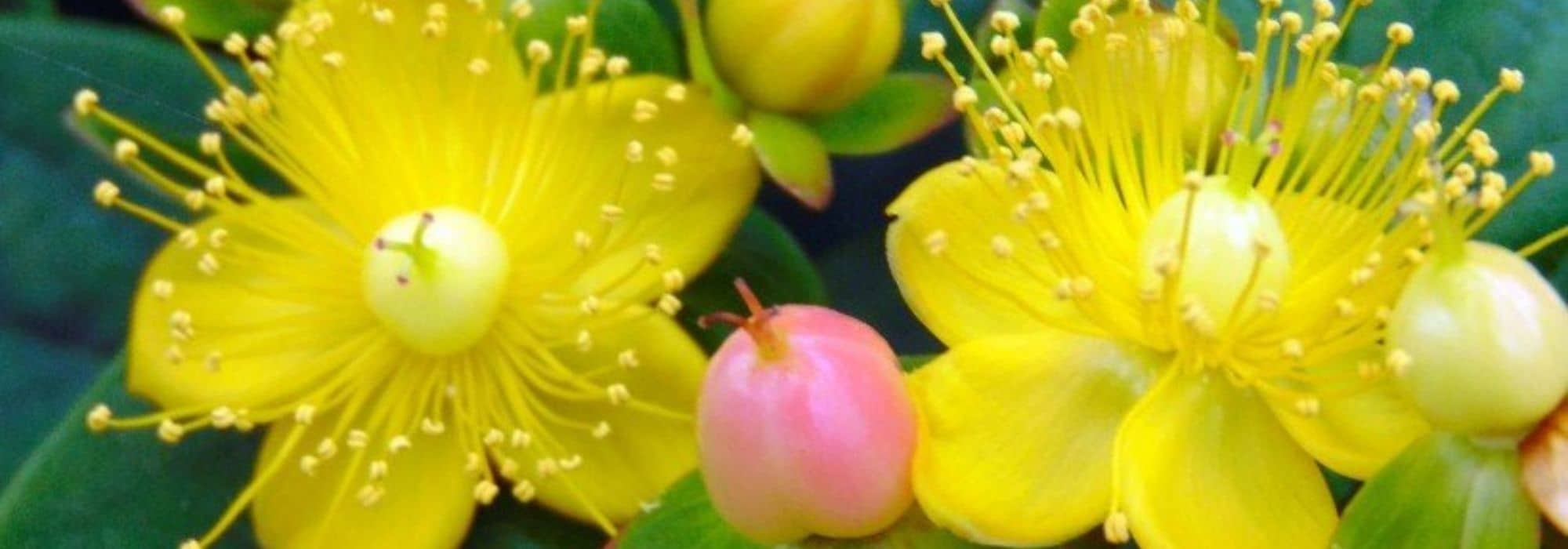
Associate St. John's Wort
6 ideas for garden or terrace combinations
Contents
The St John’s Wort, also known as Hypericum, are easy-to-grow, hardy and robust shrubs that are almost foolproof. This shrub is very interesting in the garden for its long and abundant golden flowering, as well as for its decorative fruiting, which ranges from white to chocolate brown, passing through pink and red. The different varieties offer either compact or bushy habits, allowing them to be used as groundcover, as well as in isolation, in a flowerbed, a flowering hedge, or in pots. Discover our 6 pairing ideas to combine St John’s Wort in the garden and on the terrace.
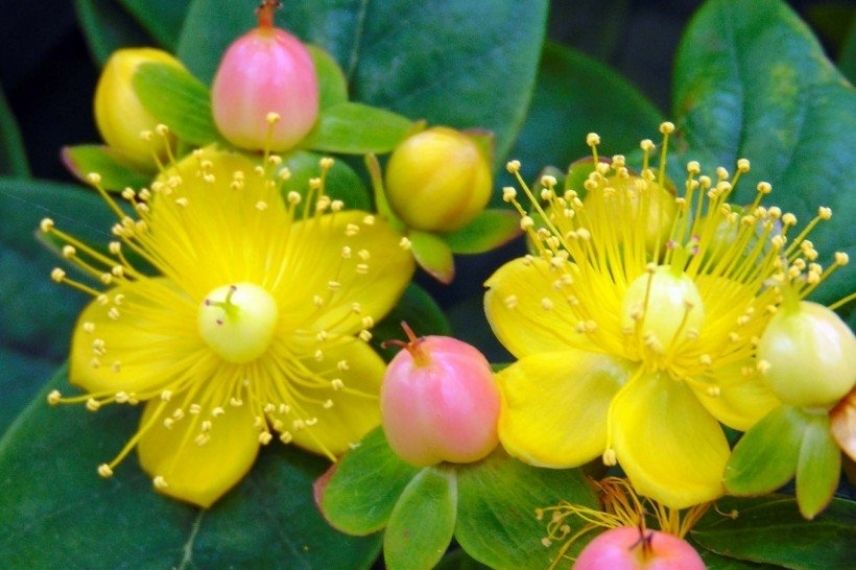
Hypericum inodorum ‘Magical Beauty’
In bush beds
Thanks to its beautiful golden flowering, St. John’s Wort will bring a touch of sunshine to the garden, especially in a bush border. At the back of the border, choose a tall variety with an upright habit like Hypericum ‘Hidcote’. In the middle of the border, most St. John’s Worts will be suitable, while at the front, you can plant shorter varieties like Hypericum dummeri ‘Peter Dummer’.
To maintain a golden flowering theme, you can pair it with a Solidago, a Japanese Kerria, and a Lysimachia punctata. You can also add some bushes in purple tones like Phormium, Berberis, Physocarpus, and a Cotinus whose foliage will echo the fiery fruiting of St. John’s Worts. Yellow will also pair well with the purple of Buddleias, the white of Kolkwitzias, Mock Oranges, and Shrubby Lavateras. If you enjoy a mix of colours, you can plant Shrub Roses, an Raphiolepis, an Abelia in dry soil, or a Weigela in moist ground.
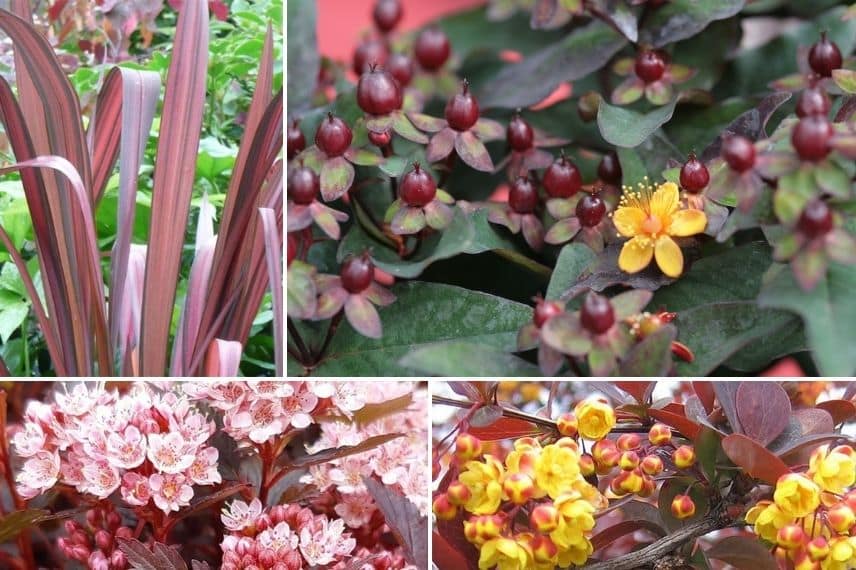
Phormium tenax ‘Evening Glow’, St. John’s Wort ‘Miracle Night’, Physocarpus opulifolius ‘Little Joker’, and Berberis ottawensis ‘Superba’
In a flowering hedge
Easy to grow and requiring no maintenance, St. John’s worts are perfect bushes for creating a flowering hedge. They will bring brightness to the garden with their golden flowerings and a splash of colour with their decorative fruits. In a hedge, opt for tall and dense varieties like Hypericum ‘Hidcote’.
To form a flowering hedge that will attract attention and pollinating insects, you can pair it with a buddleia, a Japanese Kerria, a mock orange, a spiraea, not forgetting the stunning shrub roses. To create a colourful atmosphere, add a Kolkwitzia, a Lavatera, a Weigela, a Ceanothus, and an Abelia. You can extend the flowering into winter by installing a Mahonia.
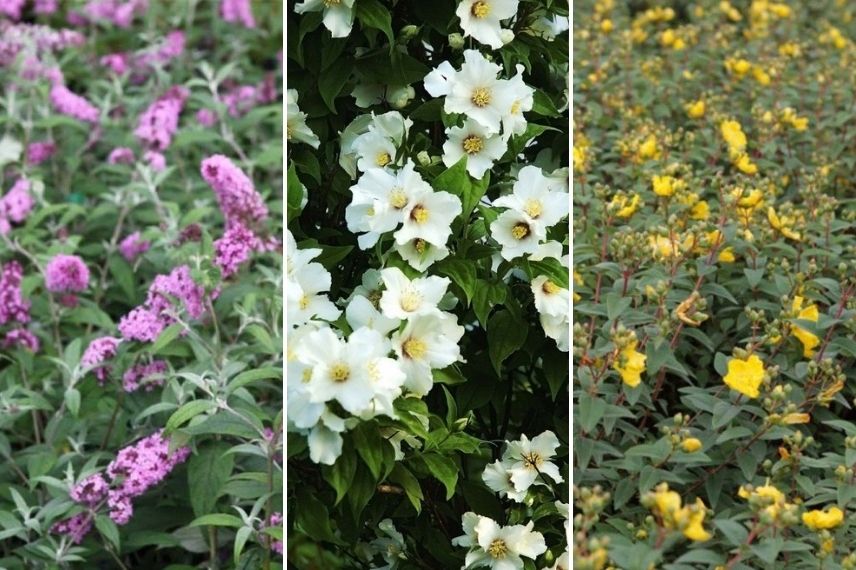
Buddleia davidii ‘Pink Delight’, garden mock orange, and Hypericum ‘Hidcote’
Discover other Hypericum - St.John's Wort
View all →Available in 0 sizes
Available in 1 sizes
Available in 1 sizes
Available in 1 sizes
Available in 1 sizes
Available in 3 sizes
Available in 1 sizes
Available in 2 sizes
Available in 1 sizes
Available in 3 sizes
In a garden of azure sunshine
Blue and yellow contrast beautifully and complement each other in a garden, creating a sunny azure atmosphere. The St. John’s Wort will naturally find its place with its yellow flowers blooming from May to September. This bush will add volume to a flowerbed alongside an impressive Kniphofia, an Achillea ‘Coronation Gold’, Rudbeckia, coreopsis, and a Helianthemum nummularium in dry soil or Heleniums with yellow flowers in moist soil. To create a symphony, add a Caryopteris with small azure flowers, a lavender, a shrubby veronica ‘Ouessant’, a Perovskia, a Vitex agnus-castus ‘Blue Puffball’, Nepetas, and not forgetting the timeless hardy geraniums. You can also add some beautiful Iris Germanica, ornamental allium bulbs, a coreopsis, a sea holly, a sage, a campanula, and a blue agapanthus. To extend the flowering into autumn, plant an Aster and a Hibiscus at the back of the flowerbed.

Shrubby veronica, campanula, Coreopsis alpinus ‘Early Sunrise’ with wood sage and sea hollies, a Caryopteris and a St. John’s Wort
As groundcover and on a slope
Small St. John’s Worts have the unique characteristic of being ground-hugging, making them delightful flowering groundcovers, such as Hypericum olympicum, which forms a lovely cushion of yellow flowers. For challenging terrains, Hypericum calycinum has the ability to establish itself anywhere and spread quickly.
Its silhouette pairs well with symphorines with decorative berries, as well as dwarf conifers, such as Picea pungens ‘Glauca globosa’, a Juniper, Berberis, ceanothes with delicate blue flowers, an Lonicera nitida, a Cinquefoil, and landscape shrub roses. Among perennial plants, it can be paired with Alchemilla, Cistus, an Convolvulus sabatius, a Heuchera with purple foliage, an Iberis, a Helianthemum, an Artemisia, and a lavender.
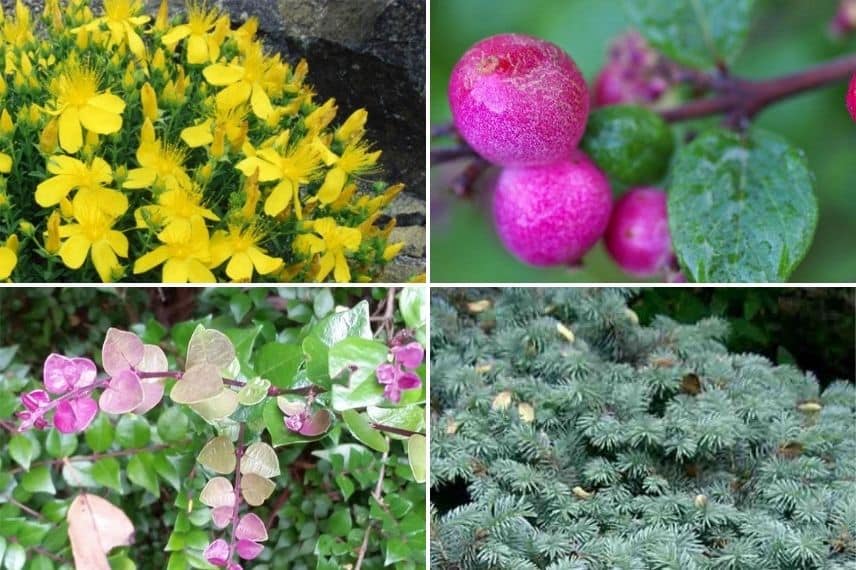
Hypericum olympicum, Lonicera nitida ‘Red Tips’, Chenault’s symphorine, and Picea pungens ‘Glauca globosa’
In a pot
Small varieties of St John’s Wort with a dense, rounded habit will make a statement in a pot or container on the terrace or balcony. They thrive in full sun or partial shade, either alone or alongside a coreopsis, a Sedum, a Thyme, a lavender, a Nepeta, an Iberis, a hardy geranium, a Shrubby Sage, Dianthus, and a small grass or a Hosta. A Heuchera will add a lovely touch of purple to the display.
To create a beautiful floral cascade, add a campanula, a Delosperma, an Aubrieta, or a Erigeron at the edge of your pot. For winter flowering, plant a Hellebore and some bulbs of snowdrops. In a larger container, you can add an Abelia, a Berberis, a small Caryopteris, and an Aster Alpinus for autumn flowering.
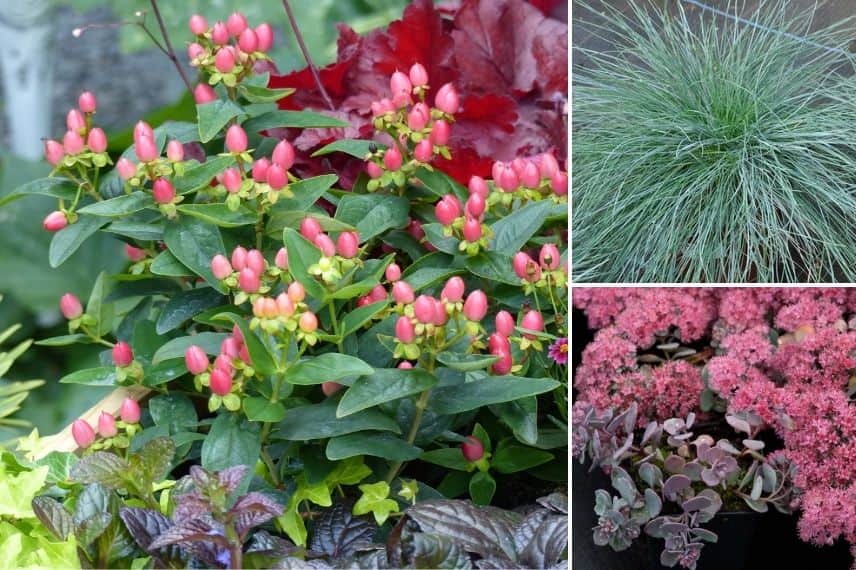
A St John’s Wort in fruit with a Heuchera, Blue Fescue, and Sedum cauticola ‘Lidakense’
In a garden of crimson and gold
Some St. John’s Worts produce attractive decorative fruit, in shades of reddish purple evolving into chocolate brown. For example, the Hypericum inodorum ‘Magical Universe’ with its purple stems contrasting beautifully with its dark green foliage, or the Hypericum inodorum ‘Rheingold’ whose purple-red leaves at bud burst turn green during summer and take on a lovely purple-violet hue in autumn.
To create a bed where gold and red blend harmoniously, you could plant a Daylily ‘American Revolution’, purple Rudbeckias, a Helenium ‘Dunkle Pracht’, the beautiful Crocosmia ‘Lucifer’, and a Coreopsis ‘Honeybunch Red & Gold’. You will also appreciate more classic partners, such as Heucheras, Dahlias, an Oriental Hellebore ‘Anémone Rouge’, and a Sage ‘Rêve Rouge’.
For grasses and graphic plants, you could include a Imperata cylindrica ‘Red Baron’, a Euphorbia amygdaloides ‘Purpurea’, and a Alstroemeria ‘Inca Pulse’. A Cotinus coggygria ‘Old Fashioned’, a Nandina domestica, a Cornus alba ‘Siberian Pearls’, and a Berberis will find their place at the back of the bed.
For further reading
- Find everything you need to know about St. John’s Wort: planting, pruning and maintenance.
- Discover our guide to choosing a St. John’s Wort for your garden or balcony.
- Browse our guide to learn when and how to prune St. John’s Wort.
- Find all our varieties of St. John’s Wort.
- Discover our advice sheet on St. John’s Wort: herbal tea and benefits.
- Subscribe!
- Contents
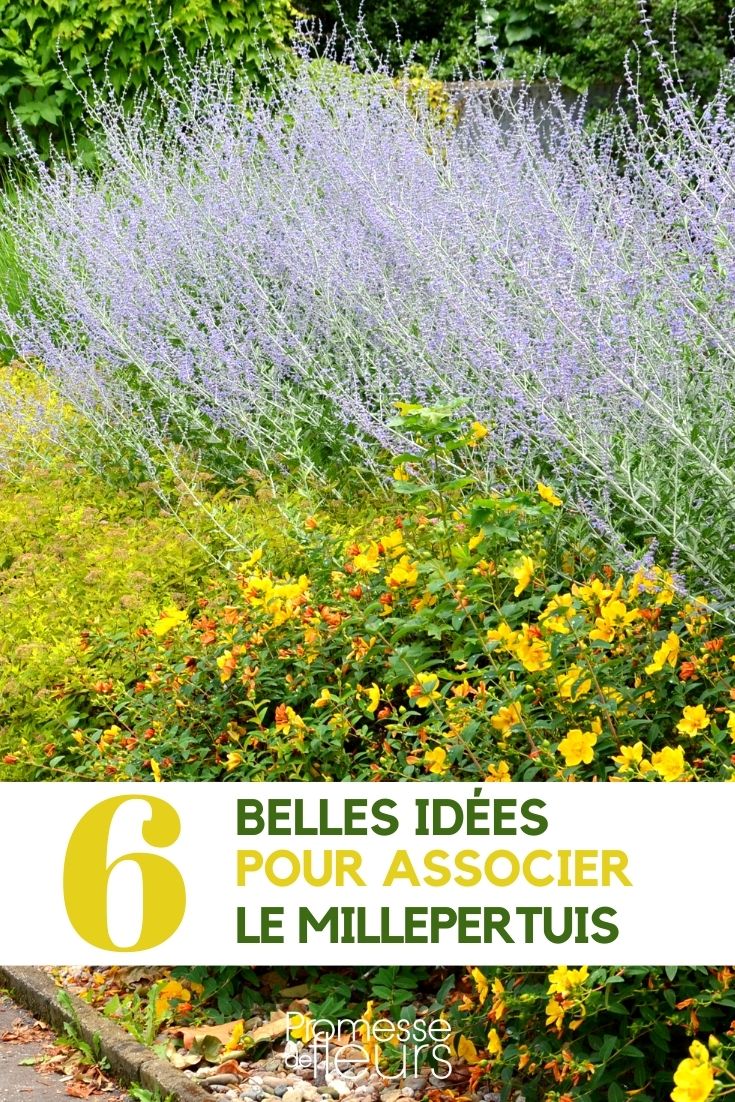































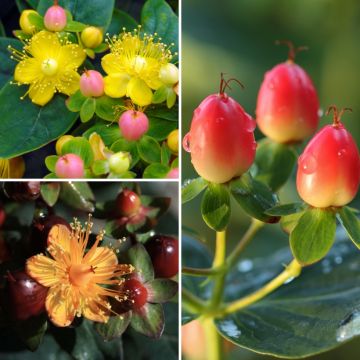
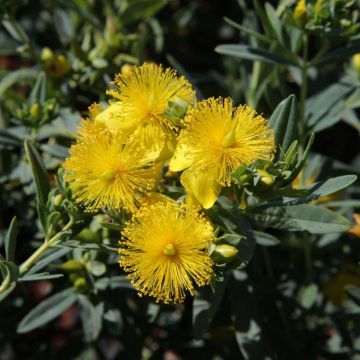

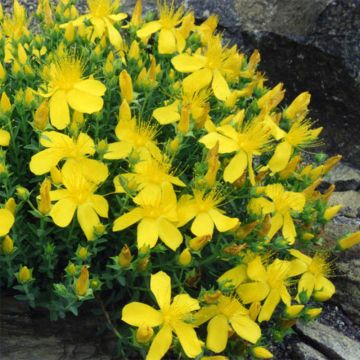
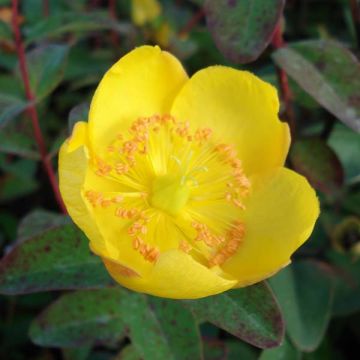
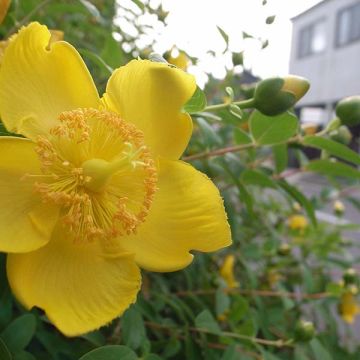

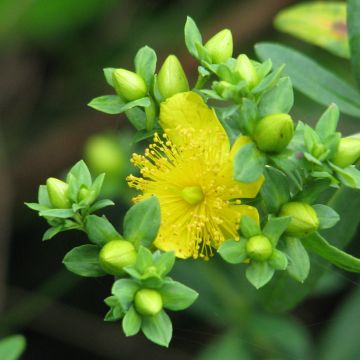



Comments